"The Class 56s dug in their heels to the point where, in the second half of 2000, they actually made something of a comeback."

We kick off our nostaligic pictorial just south of Bankers Bridge, Bromsgrove, with a real encapsulation of the times. Virgin HST sets in mixes of InterCity and Virgin livery were common through the late 1990s. By 2000, most of the repainting was complete, but there were still plenty of opportunities to see the occasional red set with a rogue IC power car at one end. And with time running out for the last IC stock set, one complete InterCity formation was assembled in Y2K. The set above, captured on the doorstep of the new millennium at the end of summer 1999, is led by 43159.

Always a welcome sight across the network, the black and dark red of Fragonset Railways lent a classy appearance to the front end of many a loco-hauled service. With the usual seven Mk.IIs in tow, Fragonset's 47701 Waverley reaches the North Worcestershire village of Wychbold with Virgin CrossCountry's 09:35 Penzance - Manchester on Sunday 12th March 2000. The legendary Kodachrome 64 film has made a good job of preserving the detail in a difficult scene, looking into the low sunlight.
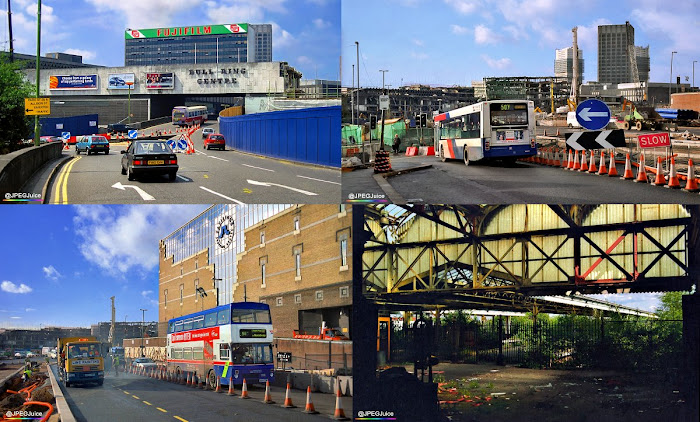
To set the post into some context, here's some of the chaos that befell Birmingham city centre around the turn of the millennium. A total wipeout of the old Bull Ring Centre, including the levelling of the one time landmark FujiFilm block. The entire traffic system was revised, and was initially marked out only with cones, as lining vehicles mapped out the new routes. The dilapidated old Moor Street station, for years abandoned and allowed to turn into a jungle, was fully renovated as part of the vast project. Demolition of the old Bull Ring took place through 2000 and into early 2001. After much preparatory work, the first signs of the new structure appeared in summer 2001, and the new Bull Ring Centre opened in September 2003.

An early morning trip to Smethwick in summer 1999 would bear witness to the Class 56-hauled 06:55 Wolverhampton - Scunthorpe, and the 06:33 Birmingham International - Manchester, which routinely comprised two North Western Class 309 sets. This is the morning of 6th August '99, with 309613 leading the way towards Piccadilly whilst a Travel West Midlands Metrobus ambles past the Guru Nanak Gurdwara in the direction of Oldbury. Both the Scunthorpe and the Manchester would lose their retro-style power by 2000.

Summer 2000 brought three weeks of major disruption which saw Proof House Junction inaccessible, and Longbridge station serving as the main Birmingham stop for the North East - South West routes. It took from 10th to 28th August to rationalise Proof House, and services returned to normal on the morning of the 29th.
During the outage, Longbridge station saw a heavy presence of Virgin staff, managing arrivals and departures from 18 Virgin CrossCountry runs between 07:25 and 19:39 each weekday. There were also additional stops at Longbridge for longer distance Central Trains services, and Alphaline trips from South Wales. Plus, of course, the already busy Cross-City timetable. Birmingham - Euston trains used the Soho loop and the Aston - Stechford line. And trains from the South Coast to the North East went via the Stechford - Aston, and then Lichfield.
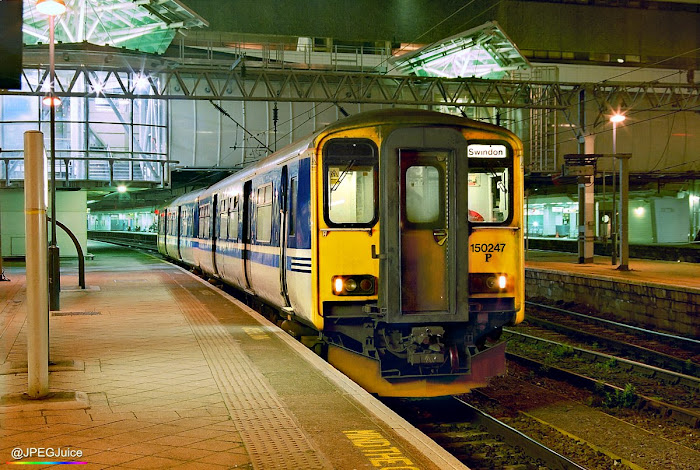
Regional Railways blue was still much in evidence, but Class 150s in the livery were not enormously common at New Street. Unless a unit came to Central on loan, appearances were limited to the odd Wales & West 150/2 making a trip up from South Wales. Above you can see one such Welsh example - 150247 - working the 20:05 Birmingham - Swindon in late March 2000.
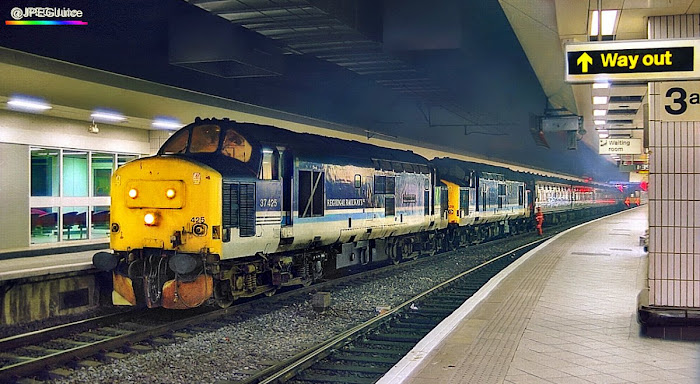
And later the same year, a rather more illustrious Regional Railways formation. This is the termination of the 18:22 SuO Holyhead - New Street, hauled by 37425 Concrete Bob and 37429 Eisteddfod Genedlaethol. The train was regularly entrusted to two 37s, but by this time in the summer of Y2K, the regime of loco-haulage was almost at an end. A few weeks on, the duty was migrated into the hands of two Class 175s. Patronage dropped, as you can imagine.

The Virgin West Coast operation was almost entirely loco-powered, and harboured a jumble of InterCity and Virgin liveries. This compilation shows: InterCity 87005 departing New Street for Euston. 86245 propelling the 15:16 Wolverhampton - Euston through Tipton. 90001 unusually at the front end of the 11:15 Wolverhampton - Euston (due to the Proof House diversions), again at Tipton. And DVT 82118 at Coventry in InterCity colours - also Euston-bound.

Although the Class 66s took over most West Midlands EWS freight duties from ex-BR locos through the course of 1999, the Class 56s dug in their heels to the point where, in the second half of 2000, they actually made something of a comeback. Above, EW&S red 56096 has aggressively snatched back its old job working the Rotherham - Wolverhampton steel bars run, and is seen at Dudley Port canal junction.

The turn of the century saw Freightliner's transition from Class 47 power to Classes 57 and 66. For a while, the commonly double-headed Leeds - Southampton Saturday service could produce Class 57/47 combinations. In this shot, taken at Widney Manor, 57010 leads 47224.

You knew Ted Rogers was in Deep Purple, right? But before Ted Rogers was in Deep Purple (Silverlink's deep purple livery, that is), Ted Rogers was in this Network SouthEast livery. The Silverlink London to Birmingham semi-fasts were solid 'Ted' duties around the turn of the century, but at that time there were still quite a few NSE jobs left. Silverlink purple was overwhelmingly prevalent on the 321s by 2001, but surprisingly, 321425 survived in its original NSE colours until 2004. This selection of shots shows the following 'Ted Rogers' 321 units: 321412 at Coventry, 321415 at Berkswell, and 321425 at Birmingham International.

The vision of mail sector Class 47/7s powering Virgin services became extraordinarily common in mid 2000, as a flood of locos displaced by the new Class 67s found themselves at a loose end. In June, all of the reinforcements wore their Res livery and mail sector names. It's a bit of a 'bashing phot', but this is 47747 Res Publica at Leamington Spa on 16th June 2000. Later in the summer, the loco was repainted in Virgin livery and given the new name Graham Farish.

Meanwhile, in the actual mail sector, the 67s had taken charge of most diesel-hauled traffic by the end of May 2000. At Longbridge station, 67007 zips its haul of post past Centro Class 323 No. 323242 in the late evening sunlight.

At the close of the 1900s, Central Trains' Class 158s were the senior DMU type on the Birmingham to Gloucester line, since CT's Class 170s were not yet sufficient in number to cover the route. By the time of this shot in June 2000, the 170s did have a presence here at Stoke Prior, but they still weren't contesting the supremacy of the ex-BR units. 158789 heads for South Wales in the first standardised version of the Central Trains green livery. Note the phone numbers on the bodyside. They were switched for a web address by 2003.
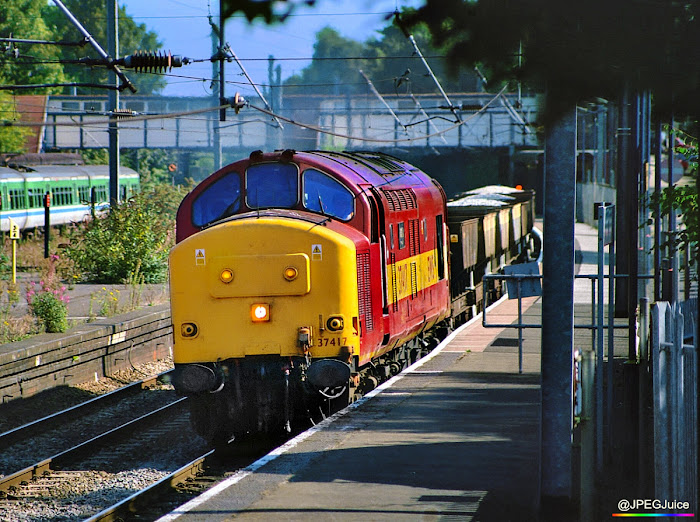
The Class 37s saw a devastating reduction in freight duties through the course of 1999. And although they did enjoy a last gasp party on Sandite duties at the end of the year, they'd become strangers to most of their former EWS strongholds by 2000, and withdrawals were heavy. In early autumn 1999, however, 37417 RAIL Magazine looks ready for the future in a nice, clean EWS red livery as it rumbles south at Kings Norton on a ballast run.

Network SouthEast livery remained very much alive on the Chiltern route from Birmingham Snow Hill to Marylebone. Here's an evening rush hour combo of Class 165 stock at Widney Manor - represented at the rear end by 165027. On the doorstep of the new millennium, these 165s were interrupted only by a group of five 168/0s in the new Chiltern livery.
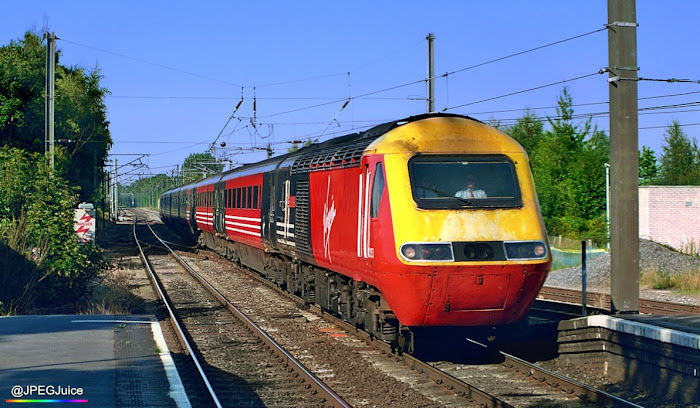
Another interesting quirk of HST lore that survived until 2000 was the spectacle of the few original Virgin repaints with yellow cab roofs. The above shot is interesting because it shows 43153 in the very brief period between the removal of its “XC” bodyside branding, and the repaint into standard Virgin livery with a dark grey cab roof. The location is Barnt Green, and the date is the very summery 24th August 2000.
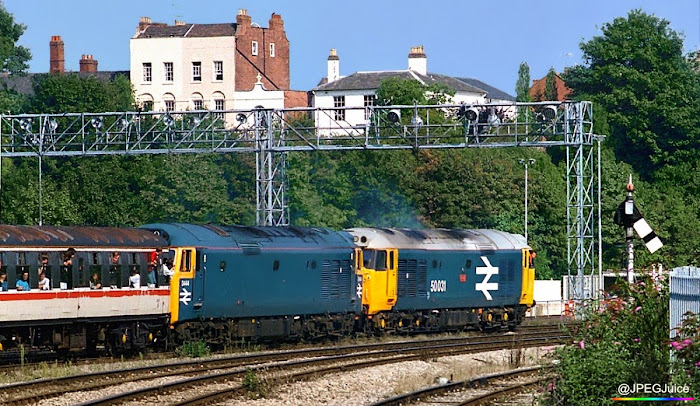
The preservation scene overflowed out onto the national network, and on Saturday 4th September 1999 served up this rather fetching view at Worcester Shrub Hill. Class 50 Nos. 50031 and D444 were assigned to the Hunslet Hoover tour - a Reading to York special which was initially planned as a duty for single-headed 50050 Fearless.

Meanwhile, on the Crewe - Cardiff route, Hastings gauge Class 33 No. D6593 was dug out for what was scheduled as a driver-training run on a miserably wet 17th August '99. In the event, the train ran as an additional passenger service, recalling the line's association with the Sulzer Type 3s in the 1980s. The old beast is seen above at Shrewsbury station.

And confined to the rather more insular environment of the Severn Valley Railway, an array of vintage traction turned out for the annual diesel gala at the end of September 2000. The event compilation above shows Class 31 No. 31108 with Class 20 No. D8000, Class 27 No. D5410, Class 50 No. D449, and EWS Class 56 No. 56006. D449 had recently been transformed from its Railfreight grey guise of 50149. Also involved in the gala were 57012, D1023 and D1013, 50007, and D431 - in a matching livery with D449.
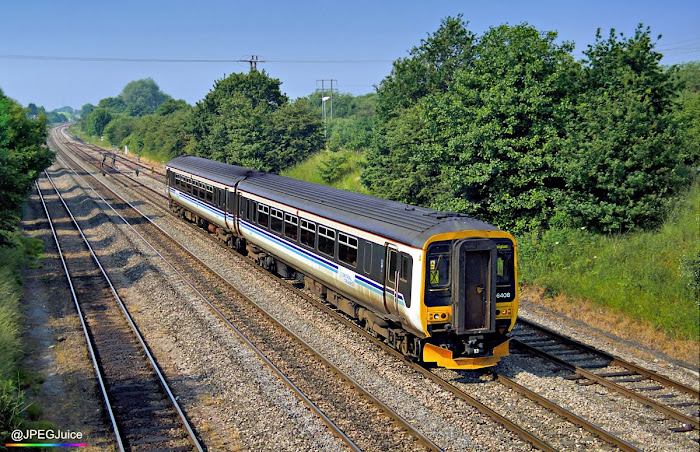
With the Class 170s still only part-way through delivery, the Central Trains Class 156 still had a big presence around Birmingham in 2000. Here at Bromsgrove, that June, 156408 was part of an overwhelming majority of CT 156s still wearing Region Railways Express colours. In fact, only 156407 had received the green Central Trains livery at this point. The service is a fast Cardiff to Nottingham run, which will not stop at Bromsgrove station.

At the end of summer 1999, one would still not bat an eyelid at a complete loco-hauled CrossCountry set in InterCity livery. On 1st September, the above shot of 47848 and its falcon grey, off white and red Mk.IIs, was very familiar at Hanbury Wharf. But by the following summer, a matching combo like this had become much more of an event, and by early 2001 the spectacle had become very rare indeed. Accelerated repainting through 2000, of not only the 47/8s, but also the stock, rendered shots like this very difficult to repeat.

The weekend of 13th and 14th May 2000 produced boiling hot weather which was more in keeping with mid July. On Saturday 13th, a trip to Finstall on the Lickey Incline bore witness to 37420 The Scottish Hosteller running light engine amid a pool change. It had not been expected that the North Wales coast would see much 'Tractor' action forward from May 2000, but events took over, and with the incoming 175 units now temporarily banned by Railtrack, First North Western needed all the Type 3 resources it could get.

Not all Class 158s on the Gloucester to Birmingham line were Central Trains stock. The Alphaline sets operated by Wales & West were yet to find a new livery, so they entirely remained in British Rail's Regional Railways Express colours. In very early spring 2000, Alphaline set 158816 is captured tackling the Lickey Incline on the way to Nottingham.

In summer 2000, all of the Central Trains Class 150s wore the Centro green livery. On 22nd August at Smethwick Junction, a nicely turned out specimen showed up in the shape of 150014. The service is en route from Stourbridge Junction to Dorridge - part of the core timetable running across Birmingham Snow Hill.
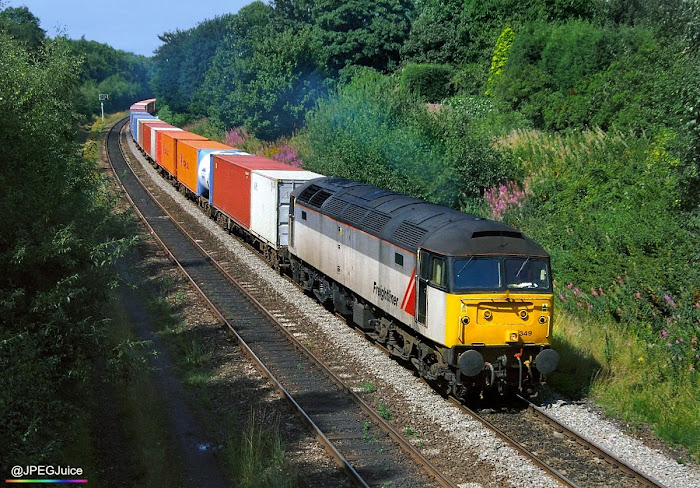
And we end with what was a very rapidly shrinking sphere of operation - first generation diesel haulage. This is Freightliner's 05:00 Coatbridge to Southampton container train, which remained in the hands of Class 47s into the early 2000s. The loco is 47349, and the location is Solihull. The arrival of the Class 57s did not greatly affect Freightliner motive power around Birmingham, but the progressive build-up of Class 66 stocks definitely did. These trains would still produce 47s into 2001, but by 2002 the availability of newer power was just too great for the Brush 4s to resist.